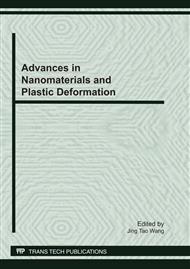p.145
p.153
p.159
p.167
p.171
p.177
p.185
p.193
p.205
Tensile Properties and Dislocation Strengthening of Commercial Pure Titanium Processed by Equal-Channel Angular Pressing at Liquid Nitrogen Temperature
Abstract:
Equal channel angular pressing (ECAP) of a quenched commercial pure titanium (CP-Ti) (grade 2) has been successfully performed at liquid nitrogen temperature with an imposed equivalent strain of about ∼0.5, and its microstructures, tensile properties and dislocation strengthening were investigated. High-resolution transmission electron microscopy (HRTEM) shows that the ECAPed CP-Ti presented a microstructure containing lattice distortions, dislocations, stacking defects and deformation twins. Tensile tests indicate that the ECAPed CP-Ti had yield strength of ~700 MPa (40 % higher than that of the unECAPed CP-Ti) and a high level of tensile ductility (~28%). X-ray diffractometer (XRD) data indicate that the ECAP processing not only broaden the XRD peaks significantly but also decreased texture considerably. The theoretical analysis by using Taylor equation based on the coherent diffraction domain size and the lattice micro-strain obtained from XRD line broadening analysis illustrates that ECAP-resulted dislocation made a strengthening contribution of about ~35.1 %.
Info:
Periodical:
Pages:
171-176
Citation:
Online since:
March 2011
Authors:
Price:
Сopyright:
© 2011 Trans Tech Publications Ltd. All Rights Reserved
Share:
Citation:


